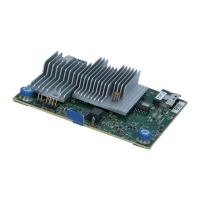It allows any two drives to fail without loss of data.
RAID 60RAID 60
RAID 60 is a nested RAID method in which the constituent drives are organized into several identical RAID 6 logical drive sets (parity groups). The smallest
possible RAID 60 configuration has eight drives organized into two parity groups of four drives each.
For any given number of hard drives, data loss is least likely to occur when the drives are arranged into the configuration that has the largest possible number of
parity groups. For example, five parity groups of four drives are more secure than four parity groups of five drives. However, less data can be stored on the array
with the larger number of parity groups.
The number of physical drives must be exactly divisible by the number of parity groups. Therefore, the number of parity groups that you can specify is restricted
by the number of physical drives. The maximum number of parity groups possible for a particular number of physical drives is the total number of drives divided
by the minimum number of drives necessary for that RAID level (three for RAID 50, 4 for RAID 60).
A minimum of 8 drives is required.
The maximum number of drives supported for RAID 60 is 256.
All data is lost if a third drive in a parity group fails before one of the other failed drives in the parity group has finished rebuilding. A greater percentage of array
capacity is used to store redundant or parity data than with non-nested RAID methods.
This method has the following benefits:
Higher performance for RAID 6, especially during writes.
Better fault tolerance than RAID 0, 5, 50, or 6.
Up to 2n physical drives can fail (where n is the number of parity groups) without loss of data, as long as no more than two failed drives are in the same parity
group.
Parity groupsParity groups
When you create a RAID 50 or RAID 60 configuration, you must also set the number of parity groups.
You can use any integer value greater than 1 for this setting, with the restriction that the total number of physical drives in the array must be exactly divisible by
the number of parity groups.
The maximum number of parity groups possible for a particular number of physical drives is the total number of drives divided by the minimum number of drives
necessary for that RAID level (three for RAID 50, four for RAID 60).
This feature has the following benefits:
It supports RAID 50 and RAID 60.
A higher number of parity groups increases fault tolerance.
InitializeInitialize
Initialize a logical drive after you configure it. When you initialize the logical drive, you prepare the storage medium for use.
CAUTION:CAUTION:
All data on the logical drive is lost when you initialize it. Before you start this operation, back up any data that you want to keep.
SubtopicsSubtopics
Fast initializationFast initialization
Full initializationFull initialization
No initializationNo initialization
Fast initializationFast initialization
During fast initialization, firmware quickly overwrites the first and last 8 MB regions of the new logical drive, clears any boot records or partition information, and
then completes the initialization in the background. Monitor the progress of the initialization process using the progress indicator.
RAID levels that use parity (RAID 5, RAID 6, RAID 50, and RAID 60) require that the parity blocks be initialized to valid values. Valid parity data is required to
enable enhanced data protection through background controller surface scan analysis and higher write performance (backed out write).
After parity initialization is complete, writes to a RAID 5 or RAID 6 logical drive are typically faster because the controller does not read the entire stripe
(regenerative write) to update the parity data. This feature initializes parity blocks in the background while the logical drive is available for access by the OS.

